
Mictyris is a genus of brightly coloured crabs, placed in its own taxonomical family, the Mictyridae. It inhabits the central Indo-West Pacific region. These crabs congregate on mud flats or beaches in groups of a few thousand, and filter sand or mud for microscopic organisms. They congregate during low tide, and bury themselves in the sand during high tide or whenever they are threatened. This is done in wet sand, and they dig in a corkscrew pattern, leaving many small round pellets of sand behind them.

Xanthoidea is a superfamily of crabs, comprising seven families. Formerly, a number of other families were included in Xanthoidea, but many of these have since been removed to other superfamilies. These include Carpilioidea, Eriphioidea, Hexapodoidea, Pilumnoidea and Trapezioidea. Even in this reduced state, Xanthoidea remains one of the most species-rich superfamilies of crabs.

Discoplax is a genus of terrestrial crabs. It is very closely related to the genus Cardisoma.

Discoplax rotunda is a species of land crab in the genus Discoplax found in the Pacific Ocean.
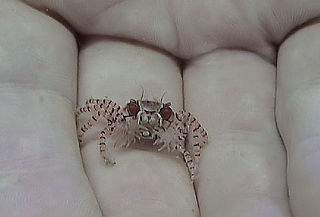
Lybia is a genus of small crabs in the family Xanthidae. Their common names include boxer crabs, boxing crabs and pom-pom crabs. They are notable for their mutualism with sea anemones, which they hold in their claws for defense. In return, the anemones get carried around, which may enable them to capture more food particles with their tentacles. Boxer crabs use at least three species of anemones, including Bundeopsis spp. and Triactis producta. The bonding with the anemone is not needed for survival, however, and boxer crabs have frequently been known to live without them, sometimes substituting other organisms such as sponges and corals for the sea anemones.
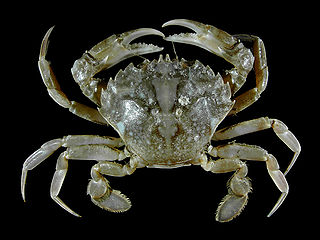
Eubrachyura is a group of decapod crustaceans comprising the more derived crabs. It is divided into two subsections, based on the position of the genital openings in the two sexes. In the Heterotremata, the openings are on the legs in the males, but on the sternum in females, while in the Thoracotremata, the openings are on the sternum in both sexes. This contrasts with the situation in other decapods, in which the genital openings are always on the legs. Heterotremata is the larger of the two groups, containing the species-rich superfamilies Xanthoidea and Pilumnoidea and all the freshwater crabs. The eubrachyura is well known for actively and constantly building its own burrows. The fossil record of the Eubrachyura extends back to the Cretaceous; the supposed Bathonian representative of the group, Hebertides jurassica, ultimately turned out to be Cenozoic in age.
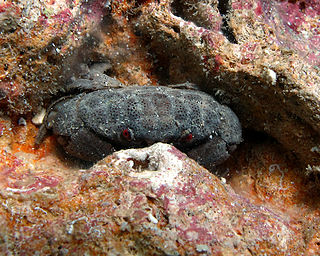
Actaeodes is a genus of crabs in the family Xanthidae, containing the following species:

Novactaea is a genus of crabs in the family Xanthidae, containing the following species:
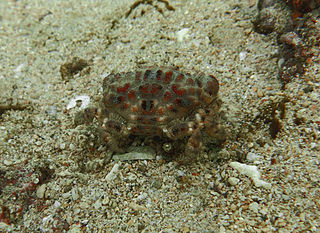
Paractaea is a genus of crabs in the family Xanthidae, containing the following species:

Cyclodius is a genus of crabs in the family Xanthidae, containing the following species:
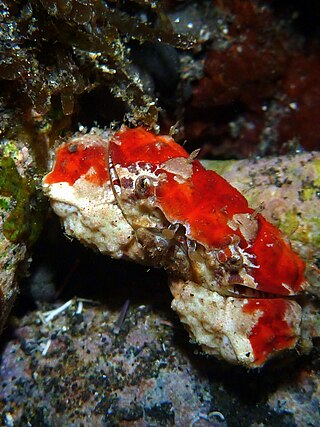
Hypocolpus is a genus of crabs in the family Xanthidae, containing the following species:
Miersiella is a genus of crabs in the family Xanthidae, containing the following species:
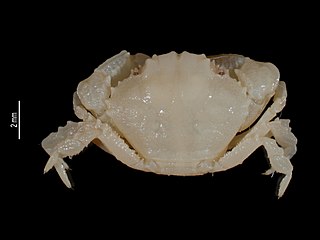
Paramedaeus is a genus of crabs in the family Xanthidae, containing the following species:

Glyptoxanthus is a genus of crabs in the family Xanthidae, containing eight species. It was originally erected by Alphonse Milne-Edwards in 1879 for six species previously placed in the genus Actaea and elsewhere. Although previously included in subfamily Euxanthinae, the genus has a quite distinct morphology from other genera in that group, and was placed in 2011 in the new, monotypic subfamily, Glyptoxanthinae by Jose Christopher Mendoza and Danièle Guinot.

Monodaeus is a genus of crabs in the family Xanthidae, containing the following species:
Actiomera is a genus of crabs in the family Xanthidae, containing the following species:

Demania is a genus of crabs in the family Xanthidae, containing the following species:
Neoxanthops is a genus of crabs in the family Xanthidae, containing the following species:
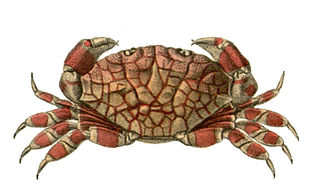
Lophozozymus is a genus of crabs in the family Xanthidae, containing the following species:

Heikeopsis is a genus of crabs containing two species, Heikeopsis japonica and Heikeopsis arachnoides. The genus was originally described under the name "Heikea" by Lipke Holthuis and Raymond B. Manning in 1990, but was later determined to be a junior homonym of the gastropod genus Heikea, erected by Orvar Isberg in 1934.
















